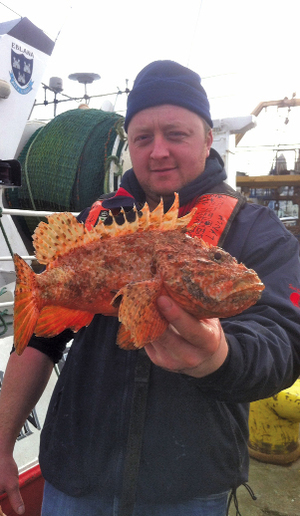Deadliest catch arrives in Howth
Dublin People 09 Mar 2013
FRIDAY dinners will never be the same again. I got a phone call last week from Peter Lynch, who was out at sea on the Howth fishing boat Eblana, about an unusual fish.
The Eblana was out fishing for ray and cod to supply the Dublin chippers when Peter and his brother Brendan noticed an unusual bright red fish amongst the catch. It was a red scorpionfish, venomous and very much alive.
The fish was carefully transferred into a holding tank while the lads made a point of avoiding the needle sharp spines which deliver venom.
I was now faced with a dilemma: would I make the 200-mile round trip to collect the fish when the boat landed in Dunmore East, County Waterford, or wait until the Eblana returned to Howth in nearly a week, hoping that the scorpionfish would still be alive?
Thankfully the risk of waiting paid off. When the Eblana landed into Howth, the fish was alive and well.
A combination of expert care and knowledge by the lads, and the hardiness of the fish, meant we now had a very rare fish from Irish waters. And even better, it was alive.
From the moment I was told about the find until I took charge of it, I used this time to research information about the Scorpionfish.
I discovered that the red scorpionfish is a deepwater fish normally found in the warmer waters of the Canaries, the Mediterranean and southern Spain.
It is considered rare in Irish waters with only four previous specimens being recorded (three in the Celtic Sea and one north of Dundalk Bay). However, this is the second time the Eblana has caught a Scorpionfish while out fishing for Dubliners’ fish.
The red scorpionfish belongs to a group that are the world’s most venomous fish. It is bright red, which may seem unusual for a fish which relies on camouflage to catch its food but at depth the colour red is not visible and will appear brown.
The body of the fish is armed with a splendid array of strong sharp spines which are loaded with venom for protection.
There is one small fish, however, which is common to our beaches that can give a painful sting, the weever fish (Echiichthys vipera).
It can be found on all the beaches around Dublin and if spiked, the sting causes an intense throbbing sensation that can last up to 24 hours.
The red scorpionfish is currently on route to the Dingle Oceanworld Aquarium in County Kerry where it will be on display in the rare fish section along with Billy the famous orange lobster which was caught north of Dublin two years ago.
Both Dingle and the National Aquarium in Galway have received rare fish that have been caught by Howth fishermen over the years.
After speaking with Pat O’Suileabhain from the National Sealife Bray recently, he is keen to provide homes for rare and unusual fish from our waters which means we won’t have far to travel to see these wonderful creatures.
Declan Mac Gabhann is Sea Fisheries Inspector at Sea Fisheries Protection Authority (SFPA), Howth Fishery Centre.











